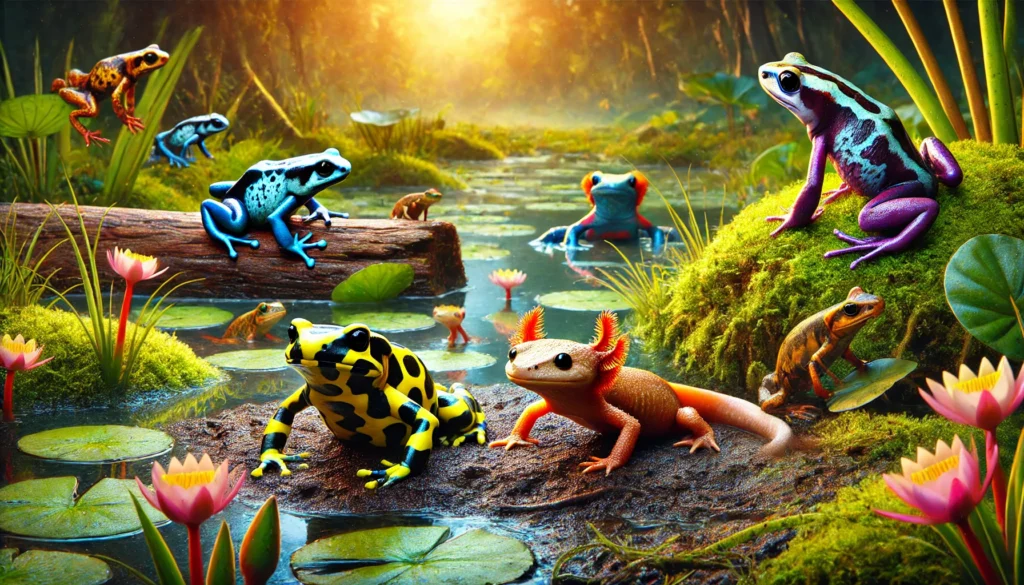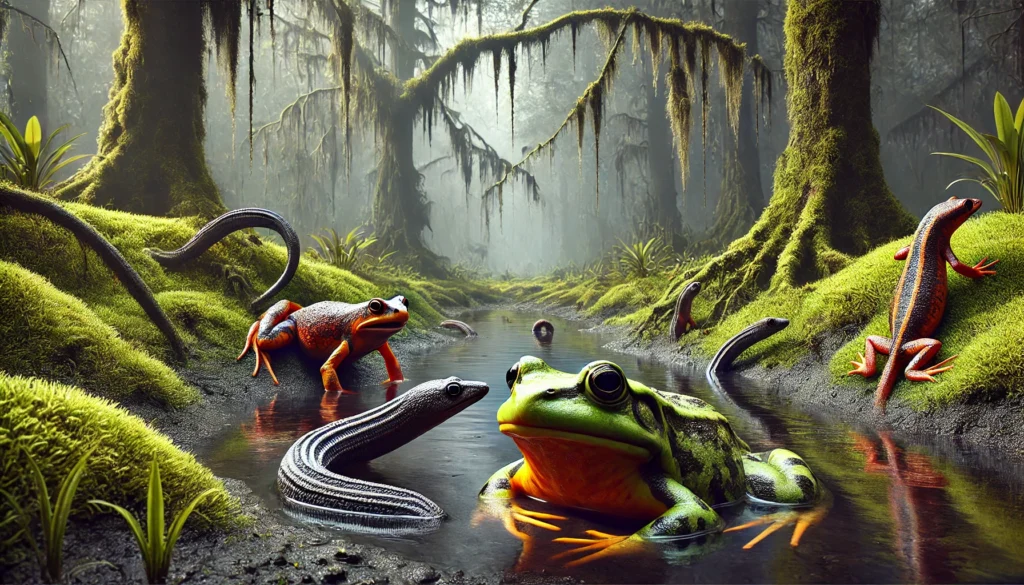When we think of wild and exotic animals, amphibians are rarely the first to come to mind. However, these incredible vertebrates possess characteristics and behaviors that are truly fascinating. As a specialist veterinarian, I invite you to embark with me on a journey through the world of amphibians, discovering their peculiarities and learning how to care for these extraordinary creatures.
The Diversity of Amphibians
Amphibians are a diverse group of vertebrates that include frogs, toads, salamanders and caecilians. There are more than 7,000 known species, spread across every continent except Antarctica. This group of animals is notable for their ability to live both in water and on land, an adaptation that has allowed them to survive for millions of years. Furthermore, many of these animals have unique characteristics that make them especially interesting for scientists and nature lovers.
Curiosities About Amphibians
- Metamorphosis: One of the most striking characteristics of amphibians is metamorphosis. Most amphibians begin life as aquatic larvae (tadpoles in the case of frogs and toads) before transforming into terrestrial adults. This process involves impressive changes in the shape and function of the body. In particular, frogs undergo a transformation from tadpole to adult that includes the development of legs and the loss of a tail.
- Permeable Skin: Amphibian skin is extremely permeable, allowing the exchange of gases and absorption of water directly from the environment. This characteristic makes them very sensitive to environmental changes, which makes them excellent indicators of ecological health. For example, the presence or absence of certain amphibian species can indicate the quality of water and air in a given area.
- Poisons and Toxins: Many amphibian species, such as the poison dart frogs of Central and South America, produce potent toxins. These poisons are used both for defense against predators and for hunting. The toxins produced by some frogs are so powerful that they can be fatal to humans and other animals. On the other hand, some of these toxins have potential for medicinal uses, including treating chronic pain.
Notable Amphibians and Their Characteristics
- Poison dart frog (Dendrobatidae): Known for their vibrant colors and potent venoms, these frogs are an excellent example of evolutionary adaptation. Its venom is used by indigenous tribes to poison the tips of hunting arrows. Additionally, their bright colors serve as a warning to predators of their toxicity.
- Axolotl (Ambystoma mexicanum): Also known as the “water monster”, the axolotl is famous for its ability to regenerate. This neotenic amphibian maintains larval features into adulthood, including external gills, and is an important model for scientific research. Interestingly, the axolotl can regenerate limbs, tail, heart and even parts of the brain, making it a focus of study for regenerative medicine.
- Chinese giant salamander (Andrias davidianus): This is the largest amphibian in the world, reaching up to 1.8 meters in length. Unfortunately, it is critically endangered due to habitat loss and illegal hunting. The Chinese giant salamander has rough skin and a robust body, adapted to living in rivers and mountain streams.
- Glass frog (Centrolenidae): These small frogs are notable for their translucent skin, which allows you to see their internal organs, including their beating heart. Glass frogs are found mainly in Central and South America, in tropical rainforests. They usually live in the leaves of trees over streams, where their eggs hatch directly into tadpoles that fall into the water below.

Essential Care for Pet Amphibians
Caring for an amphibian as a pet can be an incredibly rewarding experience, but it requires attention to specific details to ensure their well-being. Below are some essential precautions:
- Suitable Habitat: The environment should mimic the amphibian's natural habitat as much as possible. This includes temperature control, humidity and the presence of clean water. For example, tree frogs need vertical environments with lots of plants, while aquatic salamanders need submerged areas and land.
- Food: An amphibian's diet varies depending on the species. Generally, they feed on insects, small invertebrates and, in some cases, small vertebrates. It is important to provide a balanced, nutrient-rich diet. For frogs and toads, crickets and earthworms are often offered, while salamanders may prefer insect larvae and small fish.
- Hygiene and Health: Due to their permeable skin, amphibians are susceptible to skin infections and parasites. Keeping the habitat clean and regularly monitoring the animal's health is crucial. Furthermore, the water must be regularly filtered and changed to prevent the accumulation of bacteria and fungi.
- Limited Interaction: Although they can be fascinating to observe, manipulation should be kept to a minimum. Amphibian skin can be easily damaged, and oils and chemicals from human hands can be harmful. Whenever you need to handle an amphibian, make sure your hands are clean and damp to minimize stress and possible harm to the animal.
Education and Conservation
In addition to the personal pleasure of caring for an amphibian, there is also an important educational and conservation aspect. Many amphibian species are threatened with extinction due to habitat destruction, pollution and diseases such as chytridiomycosis. By learning about these animals and their needs, we can contribute to conservation efforts and educate others about the importance of protecting these species.
Conservation Initiatives
Organizations around the world are working hard to protect amphibians and their habitats. Captive breeding programs, such as those developed for the axolotl and the Chinese giant salamander, aim to increase populations at risk and reintroduce them into protected natural environments. Furthermore, environmental education campaigns seek to increase public awareness about the importance of amphibians in maintaining the health of ecosystems.
Fascination and Responsibility
Adopting an amphibian as a pet is a decision that must be taken responsibly. These animals, although less conventional, offer a unique window into the biodiversity and complexity of life. Additionally, by caring for an amphibian, we contribute to the preservation of these remarkable species, many of which face significant threats in the wild. It is essential that potential owners do detailed research into the species they wish to adopt, understanding their specific needs and committing to providing appropriate care.

Conclusion
Amphibians are true wonders of nature, with unique adaptations and fascinating life stories. From poison dart frogs with their bright colors and deadly poisons to axolotls with their impressive regenerative capabilities, these animals show us the incredible diversity and resilience of life. Caring for a pet amphibian requires attention and dedication, but the reward of observing their unique interactions and behaviors is worth every effort.
As we explore and learn more about amphibians, we not only expand our knowledge of wildlife, but also reinforce the importance of preserving these incredible animals and their habitats. The responsibility of caring for an amphibian, therefore, is not only a matter of personal pleasure, but also a commitment to biodiversity conservation. Whether you're a long-time enthusiast or someone who's just starting to become interested in these animals, there's always something new and fascinating to discover in the world of amphibians.
